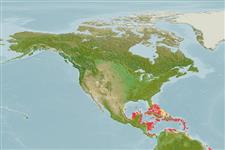Environment: milieu / climate zone / depth range / distribution range
Ecologie
marien rifbewoner; diepte 0 - 7 m (Ref. 9710). Tropical
Western Atlantic: Florida (USA), Bahamas, and Cuba south through the Antillean chain.
Grootte / Gewicht / Leeftijd
Maturity: Lm ? range ? - ? cm
Max length : 7.6 cm TL mannelijk / geslacht onbekend; (Ref. 5521)
Korte beschrijving
Morfologie | Morfometrie
Dorsale stekels (totaal): 18; Dorsale zachte stralen (totaal): 7-37; Anale stekels 2. Common amongst Labrisomids: small, often elongate fishes; largest species about 20 cm SL, most under 10 cm SL. Head usually with cirri or fleshy flaps on anterior nostrils, eyes, and laterally on nape; gill membranes continuous with each other across posteroventral surface of head. Each jaw with an outer row of relatively large, canine-like or incisor-like teeth, often with patches of smaller teeth behind; teeth usually also present on vomer and often on palatines (roof of mouth). Dorsal and anal fins long, frequently highest anteriorly; dorsal-fin spines often flexible, outnumbering segmented dorsal-fin soft rays; 2 usually flexible spines in anal fin; pelvic fins inserted anterior to pectoral-fin bases, with 1 spine not visible externally and only 2 or 3 segmented rays; all fin rays, including those of caudal, unbranched (simple). Cycloid (smooth to touch) scales present at least posteriorly on body. Body coloration: varying from drab to brilliant hues; usually with irregular vertical bands, spots, or marbled pattern. Species distinguished by: dorsal fin consisting of spines usually 18 and 7 to 37 segmented rays; pectoral-fin rays usually 14; pelvic-fin soft rays 3 (innermost ray may be reduced in length and folded over middle ray); scales in lateral-line series 40 to 69 (some scales in posterior portion of lateral line may lack sensory tubes, but are included in count); total nasal cirri (both sides) usually more than 7; two or more cirri on each side of nape just anterior to dorsal-fin origin; combination of conspicuous dark spot on anterior dorsal-fin spines and a dark ocellus extending from bases of posterior dorsal-fin spines onto dorsal contour of body not present; no small teeth behind large teeth in outer row; pectoral-fin base scales, when present, smaller than those on body; length of shortest pelvic-fin ray (third ray very difficult to see) contained fewer than 4 times in length of longest ray; maxillary bone sheathed; teeth absent on palatines (Ref.52855).
Inhabits shallow sandy and rocky areas of coral reefs (Ref. 9710). Feed on copepods, amphipods, delicate algae and occasionally of eggs of Abudefduf (Ref. 5521).
Levenscyclus en paargedrag
Maturiteit | Voortplanting | Paaien | Eieren | Fecunditeit | Larven
Böhlke, J.E. and C.C.G. Chaplin, 1993. Fishes of the Bahamas and adjacent tropical waters. 2nd edition. University of Texas Press, Austin. (Ref. 5521)
Status op de Rode Lijst van het IUCN (Ref. 130435)
Gevaar voor de mens
Harmless
Gebruik door de mens
Meer informatie
Lokale namenSynoniemenMetabolismePredatorenEcotoxicologieVoortplantingMaturiteitPaaienPaaiaggregatiesFecunditeitEierenOntwikkeling van de eieren
Leeftijd/GrootteGroeiLengte-gewichtLengte-lengteLengtefrequentiesMorfometrieMorfologieLarvenLarvale populatiedynamiekRekruteringAbundantieBRUVS
ReferentiesAquacultuurAquacultuurprofielKweeklijnenGeneticaElectrophoresesErfelijkheidZiektesVerwerkingNutrientsMassaconversie
Tools
Speciale rapporten
Download XML
Internetbronnen
Estimates based on models
Preferred temperature (Ref.
123201): 26.5 - 28.2, mean 27.5 °C (based on 510 cells).
Fylogenetische diversiteitsindex (Ref.
82804): PD
50 = 0.5000 [Uniqueness, from 0.5 = low to 2.0 = high].
Bayesian length-weight: a=0.00490 (0.00196 - 0.01224), b=3.09 (2.87 - 3.31), in cm total length, based on LWR estimates for this (Sub)family-body shape (Ref.
93245).
Trofisch niveau (Ref.
69278): 3.1 ±0.35 se; based on food items.
Fishing Vulnerability (Ref.
59153): Low vulnerability (10 of 100).
Nutrients (Ref.
124155): Calcium = 165 [80, 281] mg/100g; Iron = 0.798 [0.444, 1.387] mg/100g; Protein = 18.1 [17.0, 19.2] %; Omega3 = 0.0873 [, ] g/100g; Selenium = 18.3 [7.7, 40.8] μg/100g; VitaminA = 187 [54, 639] μg/100g; Zinc = 2.53 [1.64, 3.67] mg/100g (wet weight);
